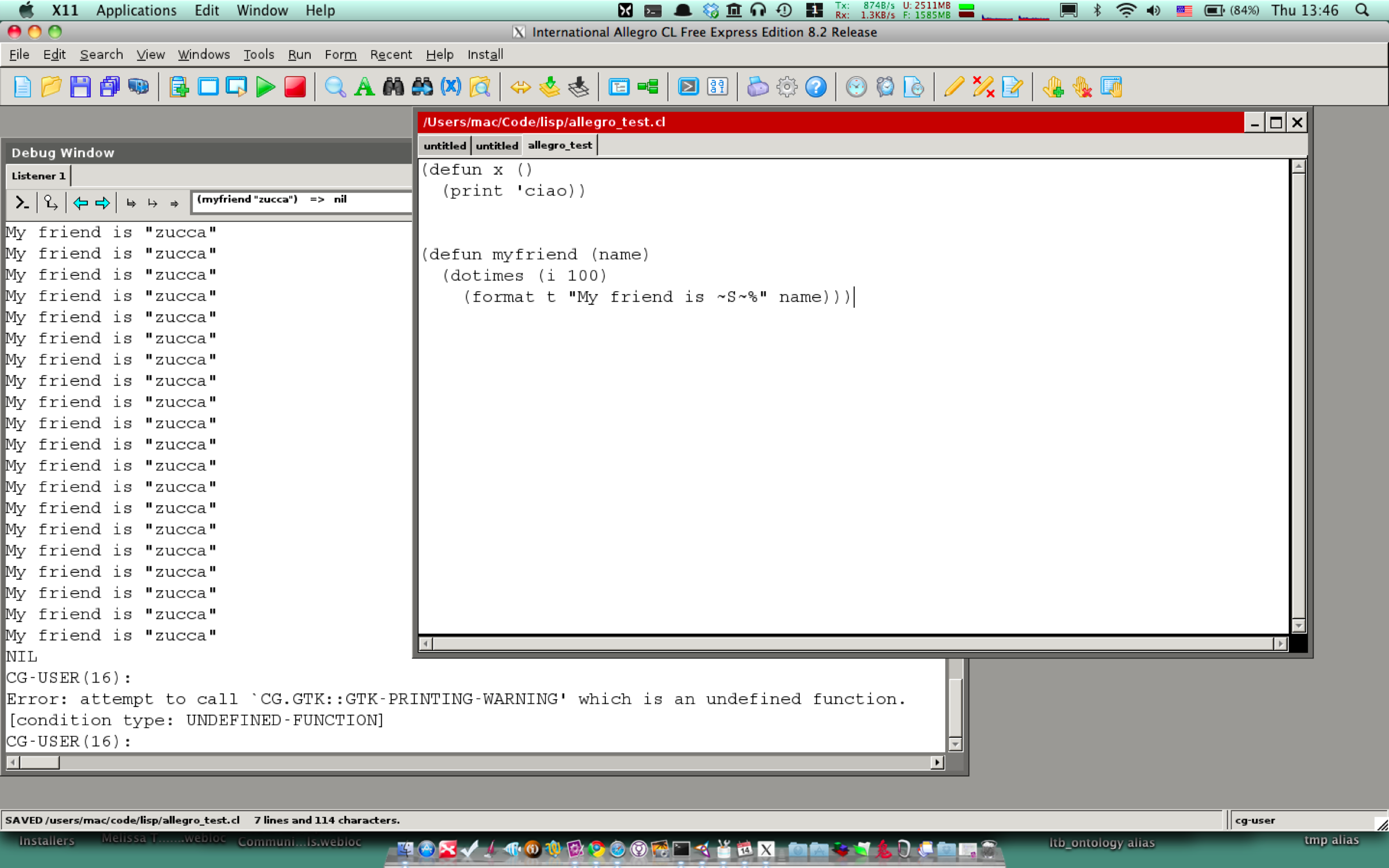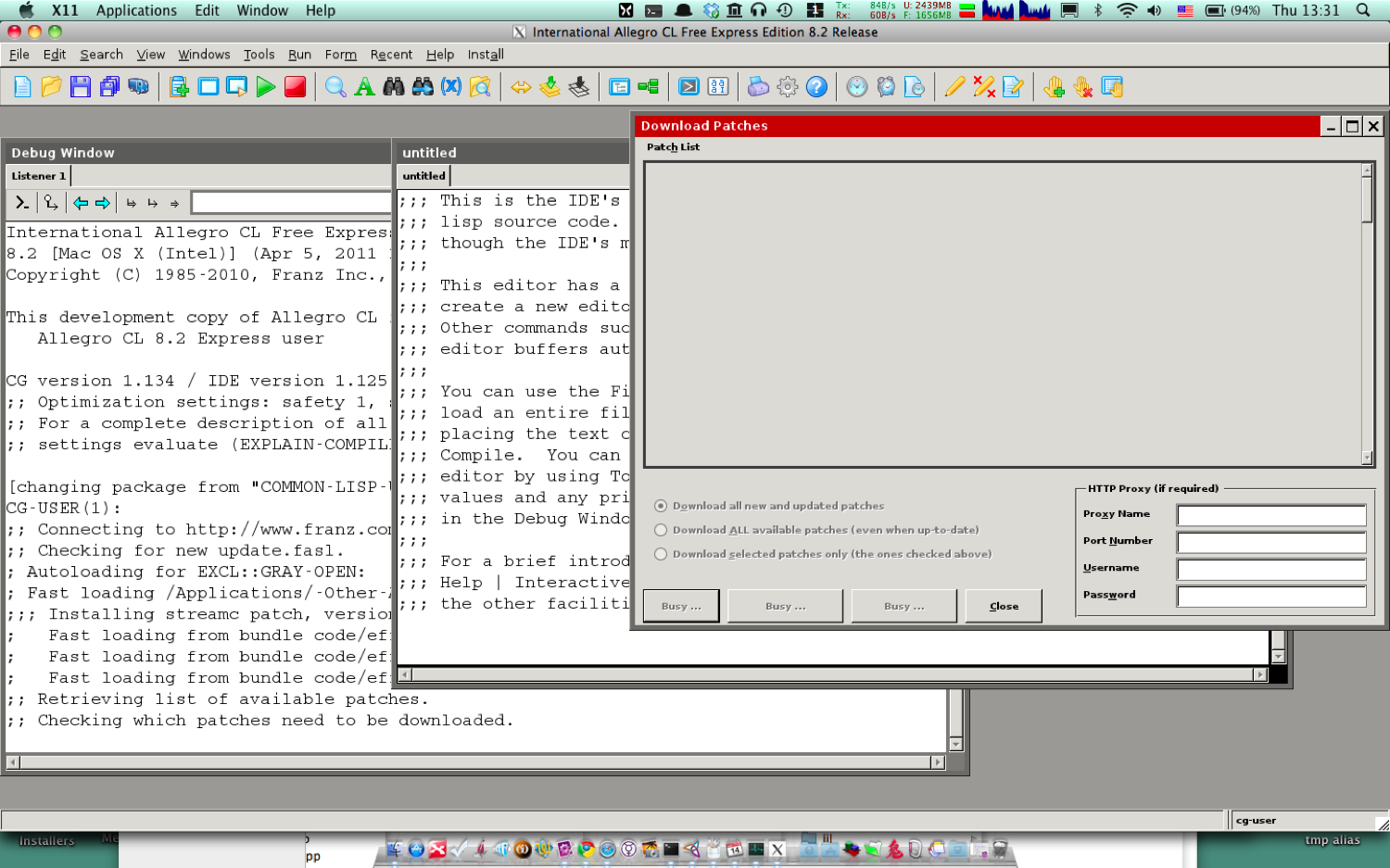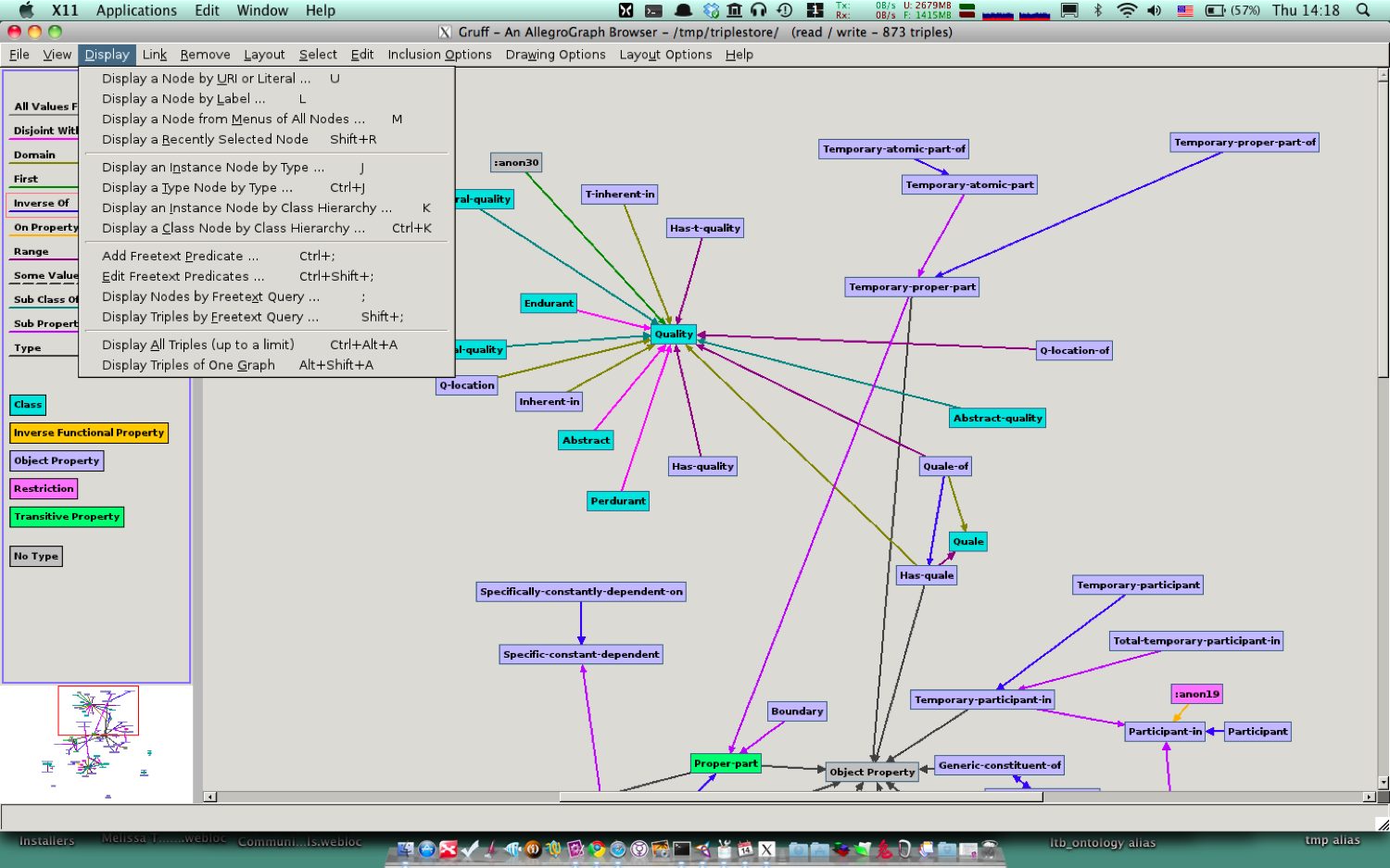RDF programming with AllegroCL and AllegroGraph
Allegro Common Lisp (wikipedia) is a commercial implementation of the Common Lisp programming language developed by Franz Inc. Allegro CL provides the full ANSI Common Lisp standard - but more interestingly for me, it also provides a very comprehensive suite of tools for semantic web programming. So I decided to give it a go, in what follows I just put together some notes on how to get started quickly.
Franz Inc. offers a whole bunch of semantic technologies, including:
-
AllegroCL: a Common Lisp implementation (homepage | install | faq | documentation) described as the "most powerful dynamic object-oriented development system available today". It runs on all major operating systems, and it includes a cross-platform GUI too (which is not always the case for Lisp implementations!).
-
AllegroGraph: (home | docs | install) this is a high-performance, persistent RDF triplestore. It allegedly can "scale to billions of triples while maintaining superior performance" and supports SPARQL, RDFS++, and Prolog reasoning from numerous client applications (python too, as discussed in a previous post).
-
AllegroCache: (home | docs | install) this is a dynamic object caching database system. It allows programmers to work directly with objects as if they were in memory while in fact the object data is always stored persistently. It supports a full transaction model with long and short transactions, and meets the classic ACID requirements for a reliable and robust database.
-
Gruff: (home | docs | install) is an rdf graphical browser that attempts to make data retrieval more pleasant and powerful with a variety of tools for laying out cyclical graphs, displaying tables of properties, managing queries, and building queries as visual diagrams (btw thanks to Matteo for mentioning Gruff to me!)
Installing AllegroCL
The good news is that if you follow the installation instructions for AllegroCL, this will include also AllegroGraph and AllegroCache. Long story short, I was able to get started with this environment surprisingly quickly. The installation on OSX involves only two steps (after filling out a form): getting the GTK+ framework (a cross-platform graphical toolkit) and then downloading the Lisp image. Double-click, install, and et-voila' you're done with it.
Here's how the Lisp IDE looks like:
The IDE includes also an integrated patches-loading tool, which you should run straightaway to get the latest versions of several libraries needed by AllegroCL (wonder whether it's that easy to install all the standard Lisp packages too..):
Finally, in order to run AllegroGraph too it's necessary to invoke an update command manually, which is easily done:
CG-USER(3): (SYSTEM.UPDATE:INSTALL-ALLEGROGRAPH) Checking available AllegroGraph versions... Making temporary directory (/tmp/tempa18825120705a/) Retrieving agraph-3.3-acl8.2-macosx86.tgz into temporary directory Extracting tar archive /tmp/tempa18825120705a/agraph-3.3-acl8.2-macosx86.tgz Installing /Applications/AllegroCL/code/agraph.fasl Installing /Applications/AllegroCL/agraph/
*********************
To use the newly downloaded AllegroGraph you can load it by evaluating the following forms:
(REQUIRE :AGRAPH)
Ancillary files are located in ``/Applications//AllegroCL/agraph/''.
Installing Gruff
I also downloaded Gruff and ran it. Again, on OSx the whole process was very very straightforward. I loaded up an ontology stored in an RDF/XML file and here's the result:
Very very impressive - that's my conclusion. Gruff offers plenty of features for viewing and also editing the rdf graph (check out the video tutorials on the homepage); with a little practice, I think it wouldn't be that difficult to use it for creating rdf models by hand (eg as an alternative to tools like Protege). The main advantage in my view is that it's highly interactive: being able to switch very quickly from a graph-view to a tabular one is extremely practical when inspecting or creating an rdf model.
Time to write some code
Haven't been writing Lisp in a while, but since we've got till here it would be a shame not to get our hands dirty a little, right?
- Tip: a nice folk named Mark Watson has written a couple of books that show how to use Allegro Graph, and he's making them available for free on his website (thanks!). Check them out: Practical Semantic Web and Linked Data Applications, Common Lisp Edition, and Practical Semantic Web and Linked Data Applications, Java, Scala, Clojure, and JRuby Edition
I had a quick look at the first book mentioned ("Practical Semantic Web and Linked Data Applications, Common Lisp Edition"), and tried to follow the examples presented. Here's the result..
First, let's load up AllegroGraph from AllegroCL and set up a Lisp reader macro (named '!') that makes it easier to enter URIs and literals:
CG-USER(2): (REQUIRE :AGRAPH) ; Fast loading /Applications/AllegroCL/code/AGRAPH.fasl ; Fast loading ; /Applications/AllegroCL/code/acache-2.1.12.fasl AllegroCache version 2.1.12 ; Fast loading /Applications/AllegroCL/code/SAX.001 ;;; Installing sax patch, version 1. ; Fast loading from bundle code/ef-e-anynl.fasl. ; Fast loading from bundle code/ef-e-crlf.fasl. ; Fast loading from bundle code/ef-e-cr.fasl. ; Fast loading from bundle code/streamp.fasl. ; Fast loading /Applications/AllegroCL/code/ACLRPC.fasl Loaded patch file /Applications/AllegroCL/update/pim001.001. ; Fast loading /Applications/AllegroCL/code/PROLOG.001 ;;; Installing prolog patch, version 1. ; Fast loading /Applications/AllegroCL/code/DATETIME.001 ;;; Installing datetime patch, version 1. ; Fast loading /Applications/AllegroCL/code/streamc.002 ;;; Installing streamc patch, version 2. ; Fast loading from bundle code/efft-utf8-base.fasl. ; Fast loading from bundle code/efft-void.fasl. ; Fast loading from bundle code/efft-latin1-base.fasl. ; Fast loading from bundle code/streamm.fasl. ; Fast loading from bundle code/ef-e-crcrlf.fasl. Loaded patch file /Applications/AllegroCL/update/agraph/3.3/pio001.001. Loaded patch file /Applications/AllegroCL/update/agraph/3.3/pio002.001. Loaded patch file /Applications/AllegroCL/update/agraph/3.3/pio003.001. Loaded patch file /Applications/AllegroCL/update/agraph/3.3/pio004.001. Loaded patch file /Applications/AllegroCL/update/agraph/3.3/pio005.001. Loaded patch file /Applications/AllegroCL/update/agraph/3.3/pio006.001. Loaded patch file /Applications/AllegroCL/update/agraph/3.3/pio007.001. Loaded patch file /Applications/AllegroCL/update/agraph/3.3/pio008.001. Loaded patch file /Applications/AllegroCL/update/agraph/3.3/pio009.001. Loaded patch file /Applications/AllegroCL/update/agraph/3.3/pio010.001. Loaded patch file /Applications/AllegroCL/update/agraph/3.3/pio011.001. Loaded patch file /Applications/AllegroCL/update/agraph/3.3/pio012.001. Loaded patch file /Applications/AllegroCL/update/agraph/3.3/pio013.001. Loaded patch file /Applications/AllegroCL/update/agraph/3.3/pio014.001. Loaded patch file /Applications/AllegroCL/update/agraph/3.3/pio015.001. Loaded patch file /Applications/AllegroCL/update/agraph/3.3/pio016.001. Loaded patch file /Applications/AllegroCL/update/agraph/3.3/pio017.001. Loaded patch file /Applications/AllegroCL/update/agraph/3.3/pio018.001. Loaded patch file /Applications/AllegroCL/update/agraph/3.3/pio019.001. AllegroGraph Lisp Edition 3.3 [built on February 17, 2010 13:53:35 GMT-0800] Copyright (c) 2005-2010 Franz Inc. All Rights Reserved. AllegroGraph contains patent-pending technology. With patches: io001, io002, io003, io004, io005, io996, io007, io008, io009, io010, io011, io012, io013, io014, io015, io016, io017, io018, io019. T CG-USER(3): (in-package :db.agraph.user)
<The DB.AGRAPH.USER package>
TRIPLE-STORE-USER(4): (enable-!-reader)
<Function READ-TOKEN>
T TRIPLE-STORE-USER(5): (enable-print-decoded t) T TRIPLE-STORE-USER(6): (triple-store:display-namespaces) rdfs \=> http://www.w3.org/2000/01/rdf-schema# err \=> http://www.w3.org/2005/xqt-errors# fn \=> http://www.w3.org/2005/xpath-functions# rdf \=> http://www.w3.org/1999/02/22-rdf-syntax-ns# xs \=> http://www.w3.org/2001/XMLSchema# xsd \=> http://www.w3.org/2001/XMLSchema# owl \=> http://www.w3.org/2002/07/owl# TRIPLE-STORE-USER(9): !rdfs:class !rdfs:class
Next thing, we want to create a local triplestore, register a dummy namespace and add a couple of triples to it. Finally, we dump the whole triplestore in a file.
TRIPLE-STORE-USER(10): (triple-store:create-triple-store "~/tmp/rdfstore_1")
<DB.AGRAPH::TRIPLE-DB /Users/mac/tmp/rdfstore_1, open @ #x21dfc80a>
TRIPLE-STORE-USER(11): (register-namespace "kb" "http://michelepasin.org/rdfs#") "http://michelepasin.org/rdfs#" TRIPLE-STORE-USER(12): (triple-store:display-namespaces) rdfs \=> http://www.w3.org/2000/01/rdf-schema# err \=> http://www.w3.org/2005/xqt-errors# fn \=> http://www.w3.org/2005/xpath-functions# rdf \=> http://www.w3.org/1999/02/22-rdf-syntax-ns# xs \=> http://www.w3.org/2001/XMLSchema# xsd \=> http://www.w3.org/2001/XMLSchema# owl \=> http://www.w3.org/2002/07/owl# kb \=> http://michelepasin.org/rdfs# TRIPLE-STORE-USER(13): (defvar *doc1* (resource "http://www.michelepasin.org/research/")) *DOC1* TRIPLE-STORE-USER(14): *doc1* !<http://www.michelepasin.org/research/> TRIPLE-STORE-USER(15): (triple-store:add-triple *doc1* !rdf:type !kb:article) 1 TRIPLE-STORE-USER(16): (triple-store:add-triple *doc1* !rdf:comment !"what a wonderful book") 2 TRIPLE-STORE-USER(17): (triple-store:get-triples-list) (< type article> < comment what a wonderful book>) NIL TRIPLE-STORE-USER(18): (print-triples (triple-store:get-triples-list)) <http://www.michelepasin.org/research/> <http://www.w3.org/1999/02/22-rdf-syntax-ns#type> <http://michelepasin.org/rdfs#article> . <http://www.michelepasin.org/research/> <http://www.w3.org/1999/02/22-rdf-syntax-ns#comment> "what a wonderful book" . TRIPLE-STORE-USER(19): (with-open-file (output "~/tmp/testoutput" :direction :output :if-does-not-exist :create) (print-triples (triple-store:get-triples-list) :stream output :format :ntriple))
If we open the contents of the newly created "~/tmp/testoutput" file, here's what we would find:
<http://www.michelepasin.org/research/> http://www.w3.org/1999/02/22-rdf-syntax-ns#type http://michelepasin.org/rdfs#article . <http://www.michelepasin.org/research/> http://www.w3.org/1999/02/22-rdf-syntax-ns#comment "what a wonderful book" .
Finally, let's use SPARQL to launch a (quite dumb) query that retrieves all triples from the triplestore :
TRIPLE-STORE-USER(53): (sparql:run-sparql " PREFIX kb: <http://www.michelepasin.org/research#> SELECT ?article_uri ?pred ?obj WHERE { ?article_uri ?pred ?obj . }" ) <?xml version\="1.0"?>
<sparql xmlns\="http://www.w3.org/2005/sparql-results#"> <head> <variable name\="article_uri"/> <variable name\="pred"/> <variable name\="obj"/> </head> <results> <result> <binding name\="article_uri"> <uri>http://www.michelepasin.org/research/</uri> </binding> <binding name\="pred"> <uri>http://www.w3.org/1999/02/22-rdf-syntax-ns#type</uri> </binding> <binding name\="obj"> <uri>http://michelepasin.org/rdfs#article</uri> </binding> </result> <result> <binding name\="article_uri"> <uri>http://www.michelepasin.org/research/</uri> </binding> <binding name\="pred"> <uri>http://www.w3.org/1999/02/22-rdf-syntax-ns#comment</uri> </binding> <binding name\="obj"> <literal>what a wonderful book</literal> </binding> </result> </results> </sparql> T :SELECT (|?article_uri| |?pred| |?obj|) TRIPLE-STORE-USER(54):
That's all for now; this is enough to get started with Allegro-CL and the semantic web programming libraries it contains.
Mind that I've only scratched the surface here, there's lots and lots more that can be done with this environment. If you want to explore these topics further make sure you have a look at Watson's book, 'cause that's a great (and free) resource, really!
Cite this blog post:
Comments via Github:
See also:
2021
2017
paper Data integration and disintegration: Managing Springer Nature SciGraph with SHACL and OWL
Industry Track, International Semantic Web Conference (ISWC-17), Vienna, Austria, Oct 2017.
paper Fitting Personal Interpretation with the Semantic Web: lessons learned from Pliny
Digital Humanities Quarterly, Jan 2017. Volume 11 Number 1
2015
2013
paper Fitting Personal Interpretations with the Semantic Web
Digital Humanities 2013, University of Nebraska–Lincoln, Jul 2013.
2012
2011
2010
2009
2007
paper PhiloSURFical: browse Wittgensteinʼs Tractatus with the Semantic Web
Wittgenstein and the Philosophy of Information - Proceedings of the 30th International Ludwig Wittgenstein Symposium, Kirchberg, Austria, Aug 2007. pp. 319-335


